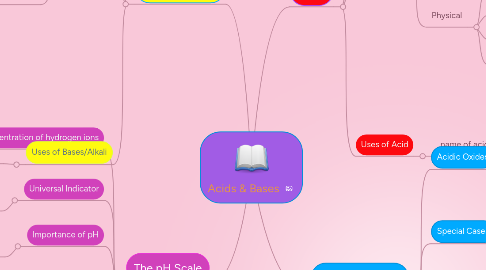
1. The pH Scale
1.1. pH and concentration of hydrogen ions
1.1.1. An acid with lower pH value is more acidic and has a higher concentration of hydrogen ions. An alkaline solution with a higher pH value is more alkaline. It has a higher concentration of hydrogen ions.
1.2. Universal Indicator
1.2.1. Universal indicator contains a mixture of dyes. It comes in the form of a solution or pH paper. It gives different colours in solutions of different pH
1.3. Importance of pH
1.3.1. When a person is given an injection, the substance being injected must have a similar pH to the person's blood.
1.4. Why is the pH of the soil important?
1.4.1. The pH of soil can vary from 4 to 8, depending on the type of soil. It is important to control the pH value of the soil because this affects the growth and development of plants.
1.5. How can we control the acidity of the soil?
1.5.1. Chemicals often added to the soil to adjust its pH value. Soil that is too acidic can be treated with bases such as quicklime or slaked lime.
1.6. How can we measure the pH of a green solution?
1.6.1. an indicator
1.6.2. pH sensorattached to the data logger
1.6.3. pH meter
2. Bases & Alkalis
2.1. Definition
2.1.1. A base is any metal oxide of metal hydroxide
2.1.2. An alkali is a special type of base that is soluble in water
2.2. Types of alkali
2.2.1. Examples of alkali: NaOH,kOH
2.3. Properties
2.3.1. Chemical
2.3.1.1. acid+base/alkali~>salt+water
2.3.1.2. alkali+ammonium salt~>salt+water+ammonia gas
2.3.1.3. alkali (Metal A) + metal salt solution (Metal B) ~>metal salt (Metal A) + metal hydroxide (Metal B)
2.3.2. Physical
2.3.2.1. Conduct electricity when dissolved in water
2.3.2.2. Have bitter taste
2.3.2.3. Turn red litmus paper blue
2.3.2.4. Have pH values more than 7
2.3.2.5. Soapy/Slippery feel
2.4. Uses of Bases/Alkali
2.4.1. name of base/alkali
2.4.1.1. Calcium hydroxide
2.4.1.1.1. neutralises excess acid in soil
2.4.1.2. Sodium hydroxide
2.4.1.2.1. makes soaps & detergents
2.4.1.3. ammonia (aq)
2.4.1.3.1. makes fertilisers
2.4.1.3.2. used in window cleaners to remove grease from bass
2.4.1.4. Magnesium hydroxide
2.4.1.4.1. used in toothpaste to neutralise acids on our teeth
2.4.1.4.2. used in antacid to relieve the pain of indigestion
3. Acids
3.1. Definition
3.1.1. An acid is a substance that produces hydrogen ions H+ in aqueous solution
3.2. Types
3.2.1. Mineral
3.2.1.1. Hydrochloric Acid
3.2.2. Organic
3.2.2.1. Citric Acid
3.3. Properties
3.3.1. Chemical
3.3.1.1. acid+reactive metal~>salt+hydrogen gas
3.3.1.2. acid+metal carbonate~>salt+water+carbon dioxide gas
3.3.1.3. acid+metal oxide~>salt+water
3.3.1.4. acid+metal hydroxide~>salt+water
3.3.2. Physical
3.3.2.1. Conduct electricity when dissolved in water
3.3.2.2. Have sour taste
3.3.2.3. Turn blue litmus paper red
3.3.2.4. Have pH values less than 7
3.4. Uses of Acid
3.4.1. name of acid
3.4.1.1. Hydrochloric acid
3.4.1.1.1. Removes impurities such as rust from metals
3.4.1.2. Sulfuric acid
3.4.1.2.1. Manufacture of detergents
3.4.1.2.2. Manufacture of fertilisers (ammonium sulfate)
3.4.1.2.3. As battery acid in cars (Dilute sulfuric acid reacts with lead plates and lead(iv) oxide plates in the battery to generate electrical energy)
3.4.1.3. Acetic acid
3.4.1.3.1. Food preservative & flavour enhancer
4. Types of Oxides
4.1. Acidic Oxides
4.1.1. Most oxides of non-metals are acidic oxides. They dissolve in water to form acids. Eg. sulfur dioxide+water~>sulfurous acid. They do not react with acids but with alkalis
4.2. Special Cases
4.2.1. Silicon dioxide is solid at room temperature. It does not dissolve in water, but reacts with hot concentrated sodium hydroxide to form sodium silicate
4.2.2. Silicon dioxide is solid at room temperature. It does not dissolve in water, but reacts with hot concentrated sodium hydroxide to form sodium silicate
4.3. Basic Oxides
4.3.1. The oxide of most metals are basic oxides.Most are insoluble in water. A few oxides, such as sodium oxide and potassium dissolve readily in water to form alkalis. They are solids at room temperature and react with acids to form salt and water.
4.4. Amphoteric oxides
4.4.1. Amphoteric oxides are metallic oxides that react with both acids and bases to form salt and water. Eg. zinc oxide
4.5. Neutral oxides
4.5.1. Some non-metals form oxides that have neither basic nor acidic properties
